The Apple iPhone 6s and iPhone 6s Plus Review
by Ryan Smith & Joshua Ho on November 2, 2015 8:00 AM EST- Posted in
- Smartphones
- Apple
- Mobile
- SoCs
- iPhone 6s
- iPhone 6s Plus
System Performance
One of the more popular and pervasive beliefs in this industry is that specs increasingly don’t matter. In a lot of ways, this review isn’t really the right place to address whether or not this matters, but the short answer is that things like SoC performance matter quite a bit. Outside of the display, the SoC and RF subsystems are one of the biggest power consumers in a phone today and unlike the display or RF systems the CPU and GPU can cause short spikes of enormous power consumption. At this point, we’ve seen SoCs this year that consume anywhere between 6 to over 12 watts when faced with a full load situation. The important part here is that when an SoC uses that much power, it needs to be delivering enough performance to justify the power consumption. In order to test aspects of the phone like the SoC we use our standard suite of benchmarks, which are designed to test various real-world scenarios to get an idea of what peak performance looks like.
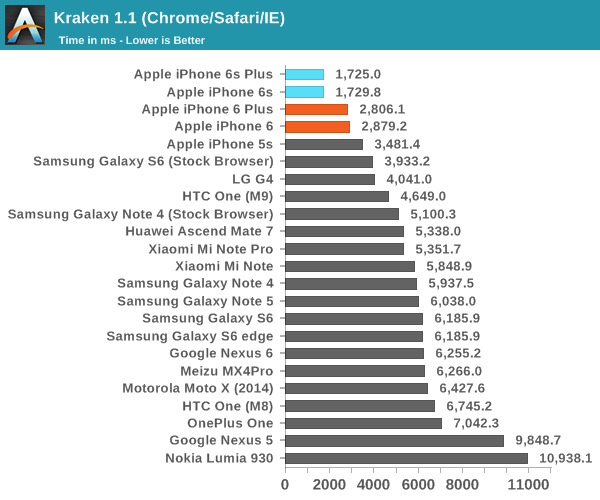
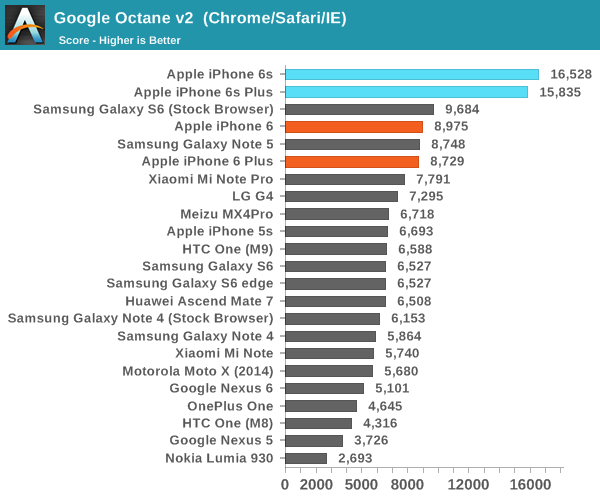
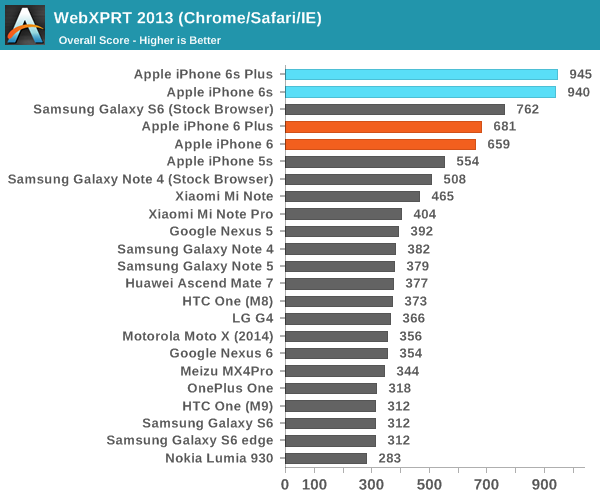
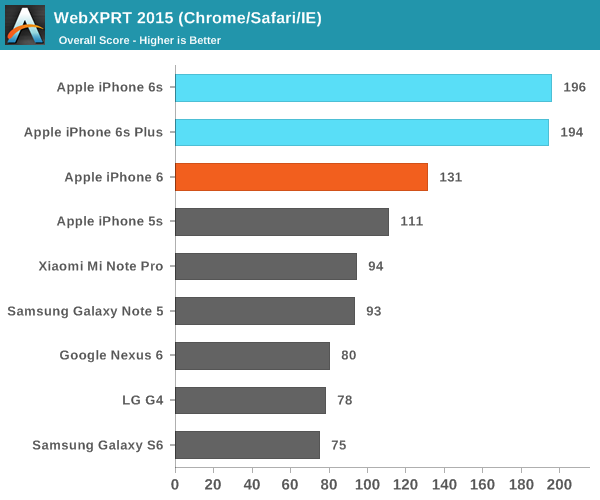
In the standard web browser benchmarks, the iPhone 6s and iPhone 6s Plus are clearly in the lead. The difference in some cases is significant, but given that the benchmarks that we’re running here are all enormous optimization targets it's still a reasonable comparison point. In the interest of trying to avoid optimization targets I decided to look at some new JavaScript benchmarks that aren’t regularly used right now. One interesting benchmark is Ember Performance, which is a JavaScript app framework that is used in a number of popular websites and applications. This isn’t as popular as AngularJS at the moment, but in the absence of a good mobile benchmark EmberJS should be a reasonably good proxy.
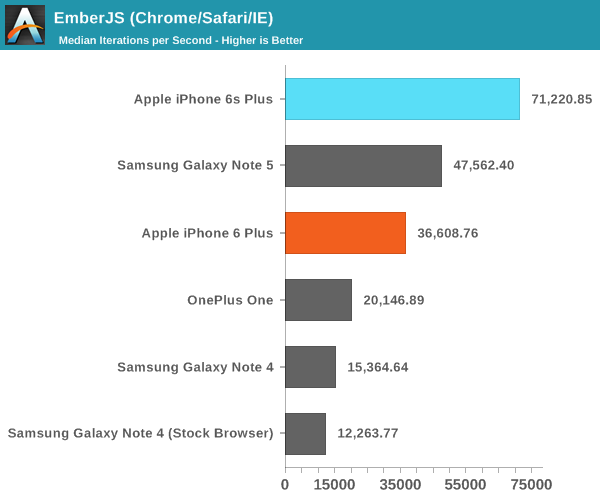
In this benchmark, we can see that there’s a pretty enormous performance uplift that results when you compare the iPhone 6s' to anything else out there on the market. Weirdly enough, on average it looks like Samsung’s S-Browser ends up slower here than Chrome, but it’s likely that this is just because S-Browser is using an older build of Chromium which negates the advantages of platform-specific optimizations that Samsung is integrating into S-Browser.

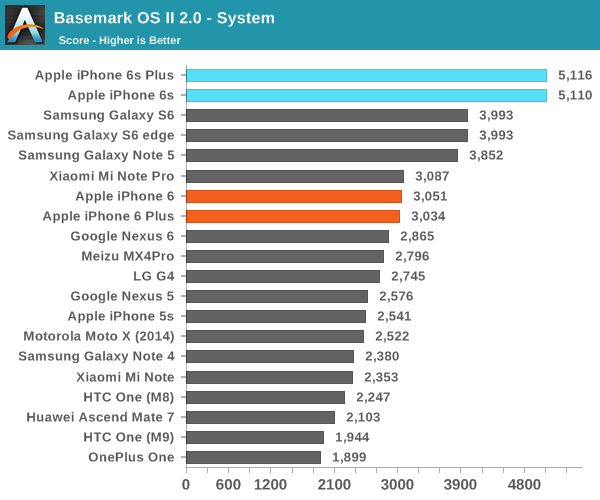
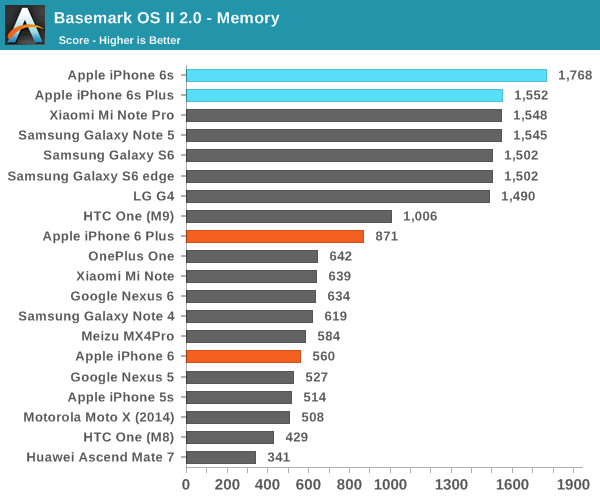
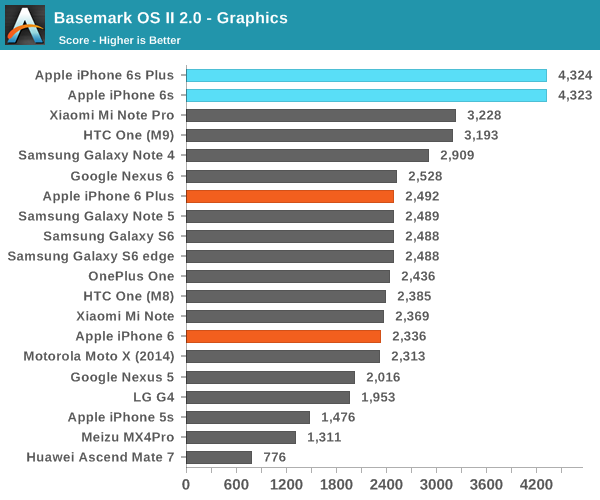
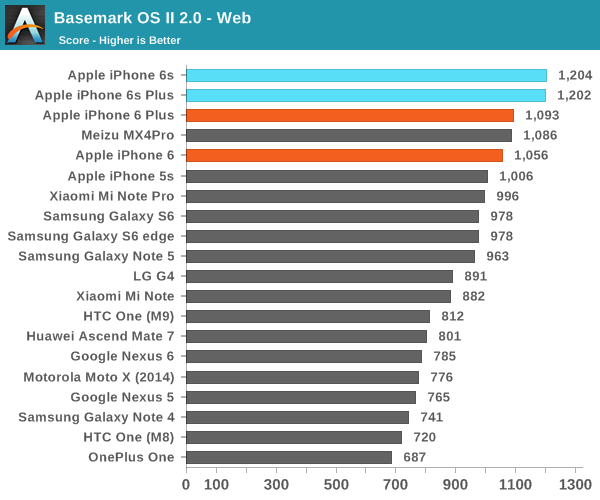
Looking at Basemark OS II, once again Apple is basically taking the lead across the board. The differences aren’t necessarily as enormous as they are in single-threaded browser benchmarks, but the iPhone 6s’ retain a significant overall performance lead over the next best mobile devices.
Overall, in benchmarks where CPU performance is a significant influence the iPhone 6s is pretty much at the very top of the stack. Of course, Apple has also had about 6-8 months of time since the launch of SoCs like the Snapdragon 810 and Exynos 7420 so this is at least partially to be expected. The real surprise and/or disappointment would be if future Exynos and Snapdragon SoCs continue to lag behind the A9 in CPU performance.










531 Comments
View All Comments
osxandwindows - Tuesday, November 3, 2015 - link
Ios problem other iPhones have it not mine tho.kmmatney - Tuesday, November 3, 2015 - link
I haven't done real tests, but overall I'd say my 6S plus has better audio that any other smartphone we've owned. So I've compared it against other iPhone and Android models, but I've never compared to the HTC M1. Nothing to complain about, for sure, onboard sound is clean and relatively loud when needed.mashuri - Wednesday, November 4, 2015 - link
Has their audio hardware changed in any notable way?mashuri - Wednesday, November 4, 2015 - link
BTW, no hissing or buzzing on my 6s+. Very clean sound on my headphones and earbuds.elpadrino27 - Tuesday, November 3, 2015 - link
I'm happy I bought the iPhone 6S Plus. Feels great after switching from the 5S. Just to let you guys know, in India, the iPhone 6S plus models are shipping with 10W power bricks in the box :)zeeBomb - Tuesday, November 3, 2015 - link
I heard of that...I guess India has more smartphone enthusiasts than here! But really, I hope apple can fix that in 2016.davidbressler - Tuesday, November 3, 2015 - link
Minor "correction" (I think).In the first table comparing the change from the 6 (both versions) to 6s (both versions) I think you left out the new front camera flash (the selfie flash). It's significant in that Apple created a new chip to drive turning the display into a flash.
David
metayoshi - Tuesday, November 3, 2015 - link
I'm surprised and very excited to hear that the iPhone 6s is using NVMe as their storage interface protocol. We're living in an exciting future.Turbofrog - Tuesday, November 3, 2015 - link
I fundamentally disagree with the technical assessment you guys have with respect to the camera. It's indefensible that Apple chose to use such a small sensor for their new camera given that the standard for flagship quality has moved forward since the iPhone 6 last year.I understand your argument for Z-height, but one could simply use the same physical focal length and accept the wider field of view. This is possible because the iPhone sensor possesses no actual technical advantages over it's competitors, it merely benefits from Apple's image processing expertise.
In essence, there is an iPhone sensor available to crop down to inside every single Galaxy S6, LG G4, or Lumia 950. With 12MP in 17.3mm^2, that's essentially the same pixel density that its 16MP or 20MP larger sensor competitors have. So if you don't like the wider field of view? Simply crop your image, and you will have the same pixel-level quality (absent processing) as you're getting from the iPhone for free.
And I would argue that given how much processing goes on behind the scenes to correct every single facet of a smartphones imaging chain, the geometric distortion associated with a wider lens, larger image circle, or faster aperture is really a moot point. There's probably a reason that you don't have access to the RAW files coming from an iPhone, and it's not because they look amazing. There are already dozens of lossy operations going on to correct distortion, remove chromatic aberration and colour casts, and lighten vignetting. It's not as if the iPhone's slower lens visibly demonstrates dramatically sharper corners or more detail than its competition, so again I don't understand why you are defending this decision.
TL;DR - the iPhone sensor and lens are technically behind the competition, a decision which only reduces image quality, and can only be realistically defended on the basis of cost-reduction measures.
JoshHo - Friday, November 6, 2015 - link
A wider field of view causes different optical compromises to be taken. In order to maintain acceptable MTF at the edges detail at the center of the photo is often compromised in response. Given the enormous issues I've seen with the Xperia Z3v with distortion, field curvature, and other aberrations I would need evidence to really believe this.